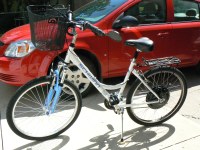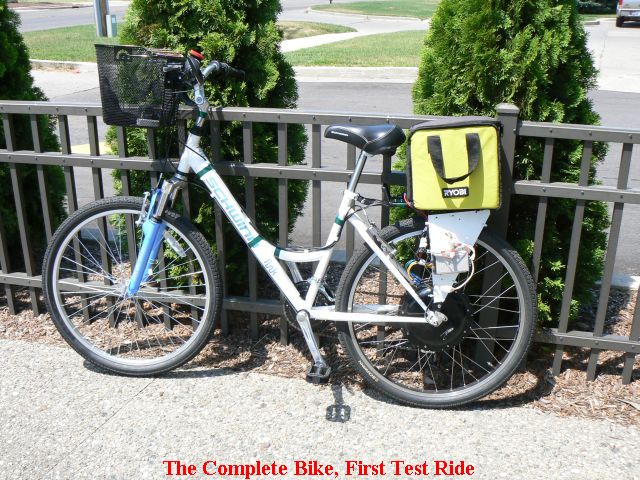 |
| Home |
| II - Getting the Parts |
| III - Assembling it All |
| IV - Controller Programming |
| V - Test Rides |
| Cost Spreadsheet |
|
|
First Test
Once programming the controller was complete, and the motor had been connected properly to the controller, it was time to take the first test ride. With a fully charged battery, I pulled the bike off the stand and walked it out to the street. I had already calibrated the speedometer, and I was anxious to see what the top speed would be. The street in front of my home is relatively flat. There is perhaps a 1 percent downward grade going North, and 1 percent upward grade going South. I headed North and gave it a little throttle. My ammeter showed 12 amps, and the bike responded nicely, and moved up quickly to 15 mph. I was pleased with the torque. I let off the throttle and let the bike coast about 100 feet. There didn't seem to be much drag. I applied the brake just enough to engage the regenerative braking, and felt a small amount of deceleration. The ammeter I had in series with the battery registered just over 2 amps.
I made a U turn and headed back. As I applied a very small amount of throttle, I felt the bike decelerate just a bit, as though the motor was holding it back. To me that was a funny feeling. Then I remembered how I had programmed the controller to have "speed" as the control mode. I guessed that what was happening was that if I was going 15 mph, and I applied just a small amount of throttle, the controller assumed I wanted just a small amount of speed, and would apply braking to accomplish that. I did several accelerations up to about 18 mph, let off the throttle completely, then applied just a tiny amount of throttle. Each time, when I applied the small amount of throttle, the bike would slow down, and the battery would receive regenerative current. While the idea of being able to apply dynamic braking using the throttle seemed interesting, I didn't like the feel of it. After a few laps up and down my street, I decided to pull back into my garage and re-program the controller. This time, on the second programming screen, I chose "torque" as the control mode.
Out onto the street again. This time, the throttle always responded as I expected. When I was going slow, a small amount of throttle would accellerate me slowly up to a slow speed. If I were coasting fast, I could apply a small amount of throttle, and wouldn't get any response, but as I increased the throttle position, I could feel the bike begin to accellerate more and more. This was similar to the throttle response I had on my electric scooter.

To get an Idea of how much range the bicycle was capable of, I went for a longer ride. I took my bike first to a hill which is about 1/2 mile from my home. This hill has an 8% grade. I started my run at the bottom of the hill, going about 10 MPH. I applied full throttle and climbed the hill, which is about 0.15 miles (750 feet). As I reached the top of the grade, my speed was about 15 MPH. I was pleased.
I continued by turning around and coasting down the hill with the brake applied, but only enough to engage regenerative braking. My ammeter read around 3 amps all the way down the hill. From there, I toured the center of town. I went to the high school and got on the running track, which is quite flat, and tried out top speed. It topped out at 26.2 MPH. On my way back home, I came back up the 8% hill at full throttle. At the top of the hill, I stopped and felt the controller and motor They both felt just a little warmer than my body temperature. This was while the ambient temperature was around 84 degrees. As I pulled into my driveway, my odometer registered 12.1 miles, and the battery pack measured 47 volts. I plugged in my 2 amp charger, and checked back after 2 hours. The charge had completed. Not bad. I could probably get at least 20 miles out of my pack, and that's enough to get to and from work.
Second Test - Round Trip To Work And Back
Monday, July 26, 2010 - It was a beautiful day for riding a bike. The temperature was in the low 60s, and the wind was out of the West at about 5 MPH. My ride to work is 10.4 miles.
The first mile from my house takes me into the center of Fenton. It's all downhill, so I coasted most of the way, pedaling just a bit to start out at each of three stop signs. From there on, the terrain is mostly flat for 3 1/2 miles through the city, with stops at four traffic lights. There is little traffic at 7:00 AM, so between lights, i held an almost constant 20 MPH, pedaling only when accelerating away from the red lights.
The next 5 1/2 miles are on rural gravel roads, which are chlorided and well maintained. They are very hard packed, and easy to ride on as long as you avoid the loose gravel between the tire tracks. The terrain rolls up and down, with short hills of between 5 and 8 percent grades. The average distance between peaks is just over 1/8 mile. This was a pleasant ride, and I tried to keep the speed above 15 MPH. The bike had no problem maintaining that up even the steeper slopes. The last 0.4 miles is within a hospital complex, with paved roads and a 20MPH speed limit. As I parked the bike, I read the elapsed time on my speedometer... 38 Minutes, 18 seconds. Not bad.
I plugged in my charger, and went to work. (part time job) 3 hours later, I returned to the bike. The charge was complete, so I had a full battery for my return trip. Great!.
The first 2 miles of my return trip went very smoothly, and I was on track to a 20 MPH average ride home, and then I ran into a snag. The road maintenance crew had graded the gravel road, and I had to ride the next 3 miles on loose gravel, which, for safety's sake, I took at about 10 MPH. I wasn't happy, but the weight of the bike seemed to help maintain good control, even though the gravel made for difficult balance. But by the time I got back to the paved roadways, I had lost all hopes of averaging 20MPH. My last 5 miles home, I kept the throttle wide open, holding speeds between 21 and 26 MPH. The last mile uphill, I never dropped below 18 MPH, and as I pulled into my driveway, I reached down to feel the motor and the controller. Both were only slightly warm to the touch... possibly 100 degrees at most. The ambient temperature at the time was 83F. I plugged in the charger again, and timed the charge cycle. (My charger is rated at 2 amps) It took 2 hours, 35 minutes for the charge to complete. The total watt hours drawn was 226. At $0.11/KWH, my electricity cost to charge the battery is 2.5 cents. That works out to 400 miles per dollar. Now, let's see. Gasoline is $2.69 per gallon. The Smart Car gets 45 Miles/gallon. That's about 17 mile per dollar. OK, not a fair comparison, I know, but it just illustrates how much energy we, as a nation waste on our overweight vehicles.